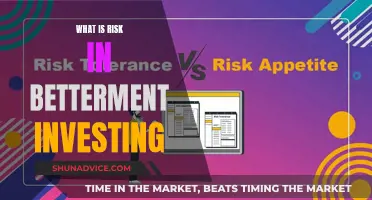
Investing in Wealthfront comes with a variety of risks. The company itself outlines several of these on its website, including market risk, advisory risk, software risk, volatility and correlation risk, liquidity and valuation risk, credit risk, legislative and tax risk, tax-loss harvesting risk, potentially high levels of trading risk, foreign investing and emerging markets risk, ETF risks, inflation, currency and interest rate risks, and college savings account risks.
Other risks of investing in Wealthfront include a minimum deposit of $500, no access to human financial advisors, and the fact that Wealthfront does not buy fractional shares of ETFs for its automated investing service.
| Characteristics | Values |
|---|---|
| Market Risk | The value of an asset class can decline due to macroeconomic changes, market sentiment, economic developments, interest rates, regulatory changes, and political, demographic, or social events. |
| Advisory Risk | Wealthfront's investment approach may not produce the intended results. There is a risk of computer equipment failure, loss of internet access, viruses, or other events that may impair access to Wealthfront's software-based financial advisory service. |
| Software Risk | Wealthfront's software may not always perform as intended or disclosed, especially in unusual circumstances. |
| Volatility and Correlation Risk | Different asset classes may exhibit similar price changes, adversely affecting the account. Past performance is not a guarantee of future results. |
| Liquidity and Valuation Risk | High volatility or lack of liquid markets may prevent Wealthfront from selling securities at advantageous times or prices. Liquidity issues may also affect certain securities. |
| Credit Risk | Financial intermediaries or security issuers may experience adverse economic events, which may impact portfolio values or management. Trading venues or settlement intermediaries could also experience adverse events, affecting the value of securities. |
| Legislative and Tax Risk | Performance may be affected by government legislation or regulation changes, including investment adviser rules, changes in tax codes, and guarantees on government securities. Wealthfront does not engage in tax planning. |
| Tax-Loss Harvesting Risk | Wealthfront's tax-loss harvesting strategy is not tax advice. The strategy may not result in the intended tax consequences, and it cannot be used to avoid penalties or interest. |
| Potentially High Levels of Trading Risk | Wealthfront's investment strategies can lead to high levels of trading, resulting in bid-ask spread expenses, trades beyond the bid-ask spread, adverse price movements, disqualification of dividends from qualified treatment, unfulfilled orders, and unforeseen trading errors. |
| Foreign Investing and Emerging Markets Risk | Foreign investing involves additional risks, including adverse currency fluctuations, political, social, and economic developments, less publicly available information, and more volatile or less liquid securities markets. |
| ETF Risks | ETF performance may not match the performance of the tracked index due to expenses, unavailability of certain securities, and supply and demand factors. ETF strategies may involve higher expenses and commission rates. |
| Inflation, Currency, and Interest Rate Risks | Security prices and portfolio returns may vary due to changes in inflation and interest rates, affecting purchasing power and the value of future dollars. |
| College Savings Account Risks | College savings accounts are subject to risks, including the possibility of losing money, changes in tax laws and regulations, plan changes, and eligibility for financial aid. |
What You'll Learn

Market risk
- Macroeconomic Environment: External economic factors such as inflation, changes in interest rates, or shifts in government policies can impact the value of investments. Inflation, for example, can reduce the purchasing power of future returns and affect the value of fixed-income investments.
- Unpredictable Market Sentiment: Market sentiment refers to the overall attitude and emotions of investors towards a particular security or market. Positive or negative market sentiment can influence investment values, and it is challenging to predict or control.
- Economic Developments: Economic factors such as economic growth, recession, or unexpected events like the COVID-19 pandemic can impact the performance of investments.
- Interest Rates: Changes in interest rates can affect the cost of borrowing and the attractiveness of certain investments. For example, higher interest rates may lead to a decline in stock prices as businesses and individuals have higher borrowing costs.
- Regulatory Changes: Changes in government regulations, such as tax policies or industry-specific rules, can impact the profitability and value of investments.
- Political, Demographic, and Social Events: Domestic or foreign political changes, demographic shifts, or social events (e.g., natural disasters) can influence market sentiment and investment values.
It is important to remember that market risk is inherent in investing, and it is challenging to predict or control all these factors. Diversification and long-term investing are often recommended as strategies to mitigate market risk.
Invest Wisely: Strategies to Earn 100K Annually
You may want to see also

Advisory risk
- There is no guarantee that Wealthfront's investment approach will produce the intended results. The company's investment strategy may not always perform as expected or disclosed, and there is a possibility of software malfunctions or other issues that may impair access to their financial advisory services.
- Wealthfront's financial advisory services are entirely software-based. While they rigorously design, develop, test, and monitor their software, there is still a chance that it may not perform exactly as intended. This means that the software may not always execute trades or provide advice that aligns with your specific needs and goals.
- Wealthfront and its representatives are not responsible for any losses to clients unless caused by Wealthfront breaching its fiduciary duty. This means that if losses occur due to factors outside of Wealthfront's control, such as market volatility or software issues, they may not be held liable.
- In the event of computer equipment failure, loss of internet access, viruses, or other technical issues, you may experience impaired access to Wealthfront's software-based financial advisory services. This could potentially lead to missed investment opportunities or delays in executing trades.
- While Wealthfront continuously strives to monitor and correct any software issues, there is always a risk of unforeseen problems that may impact the performance of their platform. It is essential for investors to understand that software-based advisory services depend on the reliable functioning of technology, which is inherently susceptible to occasional malfunctions or disruptions.
Liquidating an Inherited Investment Portfolio: A Comprehensive Guide
You may want to see also

Software risk
Although Wealthfront rigorously designs, develops, and tests its software before putting it into production, it is still possible that the software may not always perform as intended. Wealthfront continuously strives to monitor, detect, and correct any software that does not perform as expected, and it is their policy to ensure that any clients who suffer financial harm due to software issues are compensated.
However, it is important to be aware of the potential risks associated with software-based financial advisory services. These risks include computer equipment failure, loss of internet access, viruses, or other events that may impair access to Wealthfront's services. In the event of any of these issues, Wealthfront and its representatives are not responsible for any losses unless they are caused by Wealthfront breaching its fiduciary duty.
Crude Oil ETF: A Guide for Indian Investors
You may want to see also

Volatility and correlation risk
Wealthfront's investment approach is based on historical data and probability projections, but it is important to remember that past performance is not a guarantee of future results. The volatility and correlation risk associated with investing through Wealthfront means that there is no assurance that your account will perform as expected or that you will achieve your desired financial goals.
During periods of high market volatility, the price changes in different asset classes may be more closely correlated than usual. This can result in a higher level of risk for your investment portfolio. In some cases, the impact of volatility and correlation risk may be mitigated by diversifying your investments across multiple asset classes. However, even a well-diversified portfolio may be subject to volatility and correlation risk during periods of market-wide upheaval or high volatility.
It is also important to consider the impact of fees and expenses on your investment returns. Wealthfront charges a management fee of 0.25% for its automated investment service, and the funds used to build your portfolio will also carry expense ratios. These fees and expenses can affect your overall investment returns, especially over the long term.
In summary, volatility and correlation risk are inherent in investing with Wealthfront, and there is no guarantee that your investments will perform as expected. The impact of these risks may be mitigated by diversification, but it is important to carefully consider the potential impact of fees and expenses on your investment returns.
Savings, Investments, and Economics: Understanding the Equation
You may want to see also

Liquidity and valuation risk
Wealthfront's executing broker-dealer may encounter challenges in finding buyers for certain securities, which can result in a delay in selling or the need to sell at a discounted price. This situation can occur due to high volatility or the lack of deep and active liquid markets for a particular security. In such cases, Wealthfront may be forced to accept a significant discount to the market value, impacting the overall return on investment.
Additionally, the valuation of securities held in Wealthfront accounts relies on reasonably available exchange-traded security data. However, there is a risk of receiving or using inaccurate data, which could adversely affect security valuations, transaction sizes, and the resulting advisory fees paid by clients.
To mitigate these risks, Wealthfront rigorously designs, develops, and tests its software before deploying it with actual client accounts. They also continuously monitor the software's behaviour after deployment to detect and correct any issues that may arise.
It is important for investors to carefully consider liquidity and valuation risks when making investment decisions, as they can impact their ability to sell securities and the accuracy of valuations, ultimately affecting their investment returns.
Building an Investment Portfolio: The ETF Way
You may want to see also
Frequently asked questions
There are several risks associated with Wealthfront investing. Here are some of the key ones:
- Market Risk: The value of your investments can decline due to various factors beyond Wealthfront's control, such as changes in the macroeconomic environment, market sentiment, economic developments, interest rates, regulatory changes, and political or social events.
- Advisory Risk: There is no guarantee that Wealthfront's investment approach will produce the desired results. Technical issues or events may impair access to their financial advisory services.
- Software Risk: As Wealthfront delivers its financial advisory services entirely through software, there is a possibility that the software may not always perform as intended, especially in unusual circumstances.
- Volatility and Correlation Risk: Different asset classes may exhibit similar price changes, adversely affecting your account, and this risk may be more acute during periods of market volatility.
- Liquidity and Valuation Risk: High volatility or lack of liquid markets for a security may prevent Wealthfront from selling your securities at advantageous prices or times.







